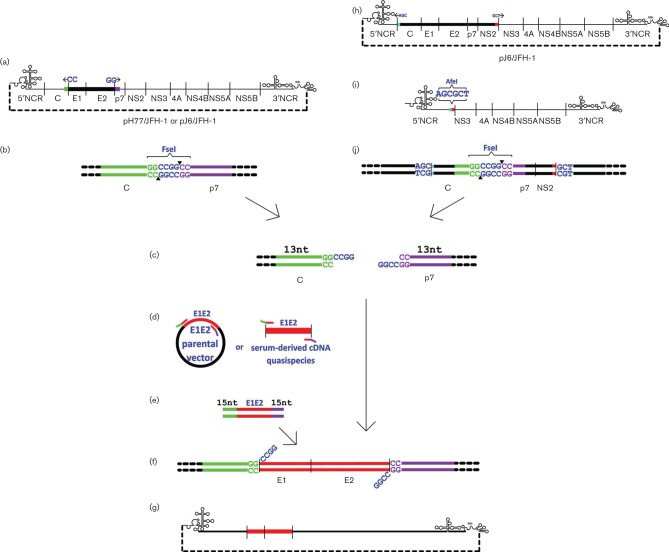Fig. 1.
ΔE1E2FseI and ΔCore-NS2 AfeI HCV cassette and chimera construction schematic. The E1E2 region of the full genomic parental clone is deleted between the naturally occurring non-overhanging termini of an RE site not found in the parental clone [FseI here, codons 171 to 742 (H77) or 748 (J6)], and replaced with the complete novel RE site by a single SDM reaction (a). The ΔE1E2FseI plasmid cassette (b) is RE digested at the novel FseI RE site (c) and assembled by In-Fusion cloning (f) with patient-derived E1E2 (d) amplified with 15 bp terminal homology to the digested cassette (e). The resulting chimera contains only wild-type sequence from both parental full-length genome and patient-derived E1E2 isolates (g). Similarly, to generate intergenotypic cassettes the Core-NS2 region of the full genomic parental clone is deleted between the naturally occurring non-overhanging termini of an RE site absent in the parental clone (h, AfeI here, codons 2–1031), and replaced with the complete novel RE site by a single SDM reaction (i). The ΔCore-NS2 AfeI plasmid cassette is RE digested at the novel AfeI site and assembled by In-Fusion cloning with in vitro synthesized Core-NS2 with 15 bp terminal homology to the digested clone and E1E2 region replaced with a unique RE site (FseI here, pre-deleting codons 171–734). The resulting ΔE1E2FseI cassette (j) can then receive patient-derived E1E2 of the same genotype as the inserted core and NS2 genes to create functional intergenotypic chimeras (c–g).

